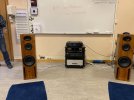the widening there is what probably causes the loss of energy on the on-axis?
however, I have a hard time believing that a neutral reverb (which is what off-axis response is) is more important than a neutral direct sound.
also note that Amir brought 1000Hz down, which is probably a result of the hole in 2-4Khz. and that's why boosting upper bass was problematic in consequence.
It's just the way I would aprouch it. boost 2-4Khz; than filling that upper bass hole; the treble problem than probably screams for solution
Howdy, there is no 'reverb', reverb is an echo effect.
The reflected off axis sound in the context of this data is not reverb.
It adds to the direct sound so quickly that it can not be considered an echo effect.(you would need a huge, huge living space to get reverb)
As Mr. Toole says, flatish direct sound is the 1st requirement of highly rated speakers.
Smooth off axis response(to allow for the 1st reflections to more 'match' the direct) with smooth directivity is a 2nd level factor, though entirely consequential. It is a strong consideration in a design along with several other traits.
So off axis is not more important - it is less important than direct sound, however it is very important. A speaker could and should have both.
As far as boosting 2000-4000hrz that area is pretty strong in total in room SPL, boosting that is not going to go well IMHO. The in room prediction even shows a tonal peak there with no boost. Obviously you could experiment and find out what you prefer.
You will be boosting the enitire horizontal spread there and the reflections will be boosted. Those stong in level refections already fill the tone there as mentioned. Yes, the direct sound will be slightly flatter but the off axis will be peaking and as it is very wide there refecting a lot of that energy right to your ears.
The listening window also already shows that dip being mostly filled in, another indicator that things might be just fine tonally.
CSS did alright withing the constrainst of a passive two way with no waveguide and a large woofer in a box cabinet.
Though it should get beaten in a blind test against a similar quality speaker that has smoother direct sound and more smoothly tracking and falling off axis.
It should be noted humans with two working ears aimed strongly at an angle from front to side never hear only the very direct sound that a single microphone does. There is always a listening window. The brain/mind also process the sound and some things have been shown to be consistent in terms of what happens there and what aspects are more and what are less consequential. Even horizontal dispersion is considered by many to be very desireable to human minds.

 www.audiosciencereview.com
www.audiosciencereview.com

 www.audiosciencereview.com
www.audiosciencereview.com


